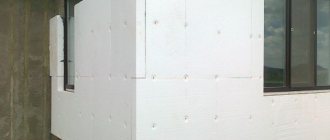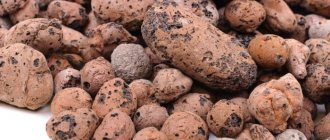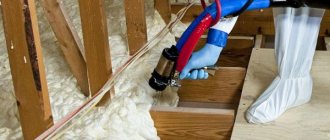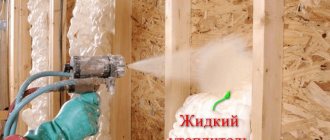Insulating the ceiling with slag, if done correctly, can not only ensure comfortable operation of the room during cold periods of the year, but also provides significant savings on heating.
Speaking about the thermal insulation of a room, it should be understood that all elements of the building are insulated, and ceilings are no exception. For these purposes, a variety of materials are used, but the most budget-friendly, but no less effective option is to insulate the ceiling using slag.
Main technical characteristics of blast furnace slag
When insulating, the main indicator is thermal conductivity . According to GOST and SNiPs, the thermal conductivity coefficient of crushed stone from blast furnace slag is 0.21 W/(m°C).
For comparison, let’s take the thermal conductivity of medium-hard mineral wool. It is 0.0326 W/(m°C). This suggests that when insulating a building structure, the layer of slag crushed stone should be thicker than the layer of mineral wool:
- Flakiness . The indicator characterizes the volume of smooth and angular elements in the filler. If the bulk of the filler consists of smooth grains, then it reduces the percentage of adhesion of the material to each other, as well as to the binder solution. The indicator is applicable only for bulk materials, such as slag insulation.
- Strength - characterizes the level of pressure and mechanical load that is maximum allowed on the filler. Slag insulation is stronger than mineral wool and polystyrene foam. Due to their rigidity, they are not prey for rodents. In this regard, insulation outperforms mineral wool, polystyrene foam, and polyurethane foam.
- Frost resistance . The parameter characterizes the number of frost cycles that the filler can withstand without changing its technical characteristics and properties. According to GOST, modern insulation materials must have a rating of at least F15 (i.e. 15 cycles). Manufacturers of all types of insulation adhere to this standard.
- Radioactivity - characterizes the class of radiation emitted. There are 3 classes, in the construction of residential buildings the 1st class is used, this applies to insulation of any type.
- Density _ This parameter shows the mass of filler per unit volume. Slag insulation is heavy insulation. Their density on average ranges from 300 to 1000 kg/m3. This is several times higher than the density of other insulation materials.
For example, the density of mineral wool averages 50-125 kg/m3. Thus, when insulating, it is necessary to take into account the high density and, accordingly, the heavy weight of the slag.
The characteristics of the filler fraction deserve special attention . The following levels are distinguished:
- 0*5 mm;
- 3*8 mm;
- 5*10 mm;
- 5*20 mm;
- 10*20 mm;
- 20*40mm;
- 25*60 mm;
- 40*70 mm.
It is recommended to use medium-sized slag as insulation. Very small and too large elements are not beneficial in thermal insulation .
Should you use sawdust?
The choice is entirely yours. There are buildings for which sawdust is quite suitable as insulation. But when insulating a residential building, it may be better not to save money, but to buy high-quality modern insulation.
Gypsum plaster of walls has been known since ancient times. All kinds of Vetonites and Rothbands had not yet been invented. This building material was mainly used by Armenians, as a result of which it received the name “Armenian plaster”. It should be noted that many could afford to call an electrician or plumber, but only very rich people could afford plastering by a master using this technology.
To this day, despite the huge variety of various plaster mixtures, “Armenian plaster” remains quite in demand.
Armenian plaster technology: preparing the mixture
First you need to mix gypsum with sawdust in a ratio of 3:1. The ingredients should be mixed dry directly on the floor. There is a second option: add sawdust to the already mixed plaster. The finished mixture should resemble sour cream in thickness.
Sawdust is the only filler that improves the sound and heat insulation of Armenian plaster. In addition, they significantly simplify the application of the finished solution to the wall surface. It is unacceptable to use shavings from a thicknesser or jointer instead - only from a circular saw (and then sifted through a sieve with five-millimeter holes).
Armenian plaster: application to the wall
Once the mixture is ready, builders only have five minutes to apply it completely. This does not mean that you need to cook very little at a time. As a rule, in the specified period of time you can use up one small bucket of plaster with some practice.
First, the solution is sprayed onto the wall. As soon as it begins to “set”, you can apply the base layer using a ladle or simply with your bare hands.
You need to work quickly, but carefully. Everything that falls to the ground can no longer be used for its intended purpose. As for the thickness of the applied layer, there are no strict restrictions: you can put as much as the base can support.
When the plane is drawn out, it is necessary to gloss it (wall putty). To do this, pure gypsum should be mixed with some kind of retarder (milk, CMC, etc.), apply the resulting solution with a trowel or spatula and smooth with strong pressure. You will get a smooth and shiny surface.
The main advantages of Armenian plaster:
1. Availability. 2. Environmentally friendly (the base consists of milk, gypsum, sawdust and water). 3. Speed of application (up to twenty square meters per day).
Unfortunately, learning the technique of Armenian plaster on your own (from books) is almost impossible. This requires extensive experience in working together with a highly qualified craftsman. It remains to add that the price for plastering work “using Armenian technology” ranges from 400 to 500 rubles per m2.
If you need a master in Rostov-on-Don to perform this or any other work, as well as advice from our managers, you can contact us by phone +7-903-401-02-93, +7-903-401-04- 26 or call a specialist to your home
Pros and cons of slag insulation
The positive features of insulation with slag fillers are:
- fire resistance;
- high speed of insulation;
- low price;
- ease of installation.
There are also negative aspects Among them:
- heavy weight of insulation. Today, slag insulation is the heaviest insulation. Their use requires a good foundation (if walls are insulated), durable structures (if floors and ceilings are insulated).
- some fillers absorb moisture, so the insulation must be well moisture-proofed.
Environmental friendliness of slag
The porous structure of the slag retains heat well.
The material in question is industrial waste. Understanding whether slag is harmful as insulation is important already at the beginning of designing a house.
The insulation technology and places where the backfill is used do not provide for direct contact with humans. Dust and gaseous emissions do not penetrate into the rooms, so they are not able to cause harm to health.
When purchasing, you must require a safety certificate. Some slags emit radioactive background.
Technology of insulation of building structures
Thermal engineering calculations and instrumental measurements show that 5 - 10% of heat leaves a home through the floor and ground, 20 -30% through the walls and the same amount through the attic floors and roof. For these building structures, you can use slag insulation.
The sequence of work to improve the thermal insulation characteristics of the floor, ceiling, and walls differs.
Floor insulation
The slag layer is poured with a concrete screed
Depending on the design of the home, floor insulation with slag in private houses is carried out differently. If in the spring and after heavy rains water appears in the subfloor or basement, waterproofing must be done.
Brief instructions for insulating an earthen floor:
- The surface is cleared of debris, leveled, and compacted if necessary.
- Waterproofing is done by covering the floor with clay dissolved in water and thoroughly mixed until it forms a dough. Another option: spread a layer of waterproofing roll material and glue the joints with mastic.
- Carefully pour a layer of insulation of the required size - the thicker the better. For most regions, adding 15–20 cm is sufficient.
- Pour 5 cm of sand and tamp it down.
- Pour a cement-sand screed (CSS) 5 - 10 cm.
If the height of the ceilings in the basement does not allow you to arrange such a “pie,” you can fill the floor with concrete using slag as a filler. Before pouring, arrange a sand cushion, which is spilled with water and compacted.
The sequence of work is simple:
- Remove debris, dirt and dust.
- Cracks and technological holes are sealed with cement mortar.
- The plate is treated with an antiseptic to prevent the occurrence of mold and mildew.
- Cover the surface with a layer of vapor barrier film (membrane), which will prevent the penetration of vapors from the basement, but will allow moisture to evaporate into the underground room. Homes with dry basements do not need a vapor barrier.
- A DSP is made on top of the heat insulator layer.
- After drying, finishing is carried out with finishing materials (laminate, chipboard, linoleum).
Calculate the weight
To determine the mass of a heat insulator, it is necessary to multiply its volume by its density. The volume is found by multiplying the layer thickness by the area determined by the product of the length and width of the thermal insulation.
We take the density of the main insulation materials from the table:
| Material | Density, kg/m 3 |
| Fibrous materials | 100 — 120 |
| Expanded polystyrene | 25 — 35 |
| Polyurethane foam | 54 — 55 |
| Expanded clay | 200-400 |
| Ecowool | 42-75 |
| Natural materials | |
| Felt (various types) | 100-150 |
| Foliage (dry) | 50 |
| Tow | 180 |
| Moss | 135 |
| Needles | 43 |
| Straw mats | 85 |
| cotton wool | 80 |
| Thin shavings (packing) | 140-300 |
| Campfire (various types) | 150-350 |
| Sphagnum (peat) | 150 |
| Wood sawdust | 190-250 |
| Straw (stuffed, cut) | 120 |
Natural materials By adding the load of thermal insulation material to the existing calculations for the load of the foundation from walls, floors, and roofs, we determine the possibility of using one or another insulation material.
How to properly insulate a ceiling under a cold roof using long-tested and well-proven insulation materials? These are heat insulators given by nature itself, the beneficial properties of which were revealed by our ancestors. These also include materials produced industrially from environmentally friendly ingredients.
Wood processing industry waste
Previously, construction was a waste-free industry. The shavings and sawdust remaining during wood processing served to protect the house from the winter cold. They were poured between the main walls and the sheathing and used to insulate the ceiling. Similar technologies are still used today.
Main advantages:
- environmental cleanliness;
- availability;
- low cost.
The disadvantage remains the high fire danger. In order to reduce this indicator, they are mixed with clay, cement, and adding fire retardant solutions. It is most advisable to use it for insulating wooden floors. Insulation from inside the room is impossible.
Immediately before starting work, the load-bearing structures of the ceiling are treated with septic tanks. A vapor barrier is installed from inside the room to prevent moisture from penetrating into the insulation volume, which can lead to:
- decreased thermal insulation properties;
- increase in insulator weight;
- gradual destruction of joist boards.
Communication passages are insulated with non-combustible materials. Electrical supply networks are enclosed in boxes or corrugated pipes.
If you use sawdust and shavings in their pure form, prevent the possibility of falling inside the room. To prevent the possibility of rodents entering, lay carbide with slaked lime as the bottom layer. After laying a layer of the required thickness, sprinkle it on top with waste slag to increase fire safety.
Using a mixture of 10 parts sawdust, 1-2 parts clay, and 1-2 parts water and fire retardants allows you to obtain non-flammable or slightly flammable insulation. For high-quality adhesion of clay and cement to sawdust, the mixture must be thoroughly wet.
Types of material
The following types of insulation are obtained from waste from metallurgical production and the energy industry:
- domain;
- metallurgical;
- fuel and coal.
Different types are used to insulate structural elements of a house.
Domain
The material is obtained by smelting cast iron. The composition includes the remains of rock, fluxes and fuel ash. The pieces are very porous, the material is free-flowing.
In private construction, the fine (heavier) fraction is used to fill cavities in walls or to screed concrete floors. The large fraction is light in weight and is suitable for backfilling attic floors.
This type of raw material is used for the production of slag heat-insulating materials.
The most suitable for insulation is slag pumice, which has good heat and sound insulating properties. It also goes into filler for cinder blocks.
Metallurgical
Metallurgical slag can create excessive stress on the foundation
This type most often includes waste from nickel and copper smelters and steel mills.
The material consists of sintered pieces of various fractions. They contain a lot of metal oxides, which is why the mass of the composition is large.
Fuel
The raw materials for production are the remains of fuel oil and coal burned in boiler houses. The fraction and properties depend on the type of combustion (chamber or layer).
Residues of fuel are hygroscopic, so before filling they must be dried for at least 2 months without exposure to precipitation.
It is used for filling cavities in brick walls or under concrete screed on floors and ceilings.
Coal
Coal slag is formed as a result of the combustion of coal and the occurrence of high-temperature reactions with the inorganic components that make up its composition. It is highly durable, as the ash content is up to 4%. The amount of unburned fuel is up to 20%, depending on the combustion method and chemical composition.
Features of coal slag are:
- volume fraction of the crystalline phase up to 80%;
- types of oxides in granules: aluminum, silicon, calcium;
- According to their chemical composition, they are super-acidic, basic and acidic.
What to consider?
It is important to select a material with an appropriate particle size. Fine sawdust from cutting wood has the best thermal insulation properties, but it is heavier, scatters during operation, and is difficult to work with.
Large chips have lower thermal protection characteristics. Therefore, it is better to use carpentry waste. This material does not have to be dried additionally, since already dried wood is used for joinery.
For thermal insulation of the house, you should choose pine sawdust, as it contains resin, which pests do not like.
Pine sawdust will save your home from pests.
Sawdust must be prepared accordingly. The material is treated with an antiseptic composition, dried well and always mixed with fluff lime to protect the insulation system from pests. The required amount of lime is at least 10% of the total mass of wood material.
The mixture is thoroughly mixed until smooth. To ensure uniform mixing, the materials are poured onto a special board made of wood or metal. Then the mass is turned over with shovels until the components are completely mixed.
The layer should vary between 20–30 cm. The secret is good compaction. This is the insulation of the roof with sawdust.
Major insulation manufacturers
One of the manufacturers of slag products is Trading House USK .
This company also sells insulation and delivers. The Aleksinsky expanded clay plant produces and sells slag, specializing mostly in the sale of expanded clay. Often coal and metallurgical companies are engaged in the sale of slag, since slag is a waste of production processes and the participation of these products.
Thus, slag insulation has many advantages . This is an inexpensive type of insulation that can be done with your own hands. The material is presented on the market, the purchase and delivery of slag insulation is established in many regions of the country.
Having high thermal conductivity, insulation with slag fillers reduces construction costs by reducing the base material when constructing walls. This affordable method of insulating rooms has proven itself over many years.
Is it possible to insulate a ceiling with slag?
Slag is sometimes used as bulk insulation. This material is inexpensive, rodents do not touch it, it does not rot and is very durable. Slag was once used as often as clay or sawdust, but this is no longer recommended. Slag still has more disadvantages than advantages: it has an uneven surface, so it is more difficult to compact it, it weighs more than expanded clay or sawdust, and its thermal insulation properties, compared to other materials, are quite low. It is especially worth noting that industrial slag cannot be used for residential premises at all, as it emits harmful substances.
Mineral wool
Modern materials are more effective in terms of thermal insulation, and therefore ceiling insulation with ursa or mineral wool is now the most popular. Such insulation materials are available in rolls and in the form of slabs of various thicknesses. These materials have many advantages: lightweight, extremely plastic, durable, wear-resistant. Insulating the ceiling in this way does not require much effort; you can handle it alone. The most important thing is to follow the technology, then the ursa will not lose its properties, and the house will always be warm.
All types of mineral wool retain heat well and do not allow noise to pass through, they are not flammable, do not emit harmful substances, and rodents do not like them. To ensure maximum insulation, the material is laid in two layers, overlapping the beams and tightly hammering the corners.
Of course, this insulation also has disadvantages. For example, mineral wool must be carefully covered with waterproofing, otherwise it will pick up moisture and lose its properties. It should also not be compacted so that there is as much air as possible in the fibers of the material.
Recommendations for thermal insulation
In the process of insulating the floor base, it is necessary to take into account several important nuances. The microclimate in the room will depend on them in the future at any time of the year:
- The height of the thermal insulation layer should be determined by the load on the coating: the greater the load, the thicker the filler layer;
- In the process of thermal insulation of a concrete base, it is advisable to use a reinforcing mesh to improve the strength characteristics of the finishing screed;
- It is advisable to place the slag on waterproofing materials, since when wet, the thermal conductivity of the thermal insulator increases sharply;
- When insulating wooden coverings, the filler is poured in such a way that there is a small air gap of at least 4-5 mm between it and the finishing boards;
- To prevent moisture from getting on the heat insulator, be sure to cover it with a vapor diffusion membrane.
Criteria for choosing slag wool
When choosing slag wool, you should first of all pay attention to material from well-known manufacturers that has good reviews. Under no circumstances buy insulation from little-known brands at dubious points of sale, where they cannot provide you with the entire list of documents, certificates and licenses for the product. In addition, consider these recommendations:
- The highest quality mineral fiber insulation is offered by German manufacturers. Only they have the most picky certification bodies that will not release low-quality or potentially dangerous products onto the market.
- Check with the seller in which direction the fibers of the insulation are located. When placed vertically, the slag wool will store heat well and absorb sound. If it is chaotic, it will be more durable and withstand dynamic loads.
- Check the GOST of the product on the packaging if the slag is domestically produced. Its presence guarantees the quality of the product.
- Choose the material that best suits your needs. The density of slag wool can be different, and the scope of its use depends on this. The density of 75 kilograms per cubic meter is suitable for insulating roofs and attics. Material with a density of 125 kg/m3 is used on floors, ceilings, and interior walls.
Price and manufacturers of slag wool
Many large manufacturers of mineral insulation are gradually abandoning the production of slag wool. Those that still produce it have a limited range. The following domestic manufacturers of this insulation are worthy of attention: CJSC Minvata, LLC, LLC Thermal Insulation Products Plant. In addition, local representative offices of large brands, such as Rockwool, Isoroc, produce a series of thermal insulators for technical purposes based on blast furnace slag. The price of slag wool is about 500 rubles per package.
Brief instructions for installing slag wool
Considering that this insulation can react critically to moisture, it is not recommended to install it on the facade of a building. Also, do not attach slag wool to a metal frame. If you plan to insulate vertical or inclined surfaces, then use wooden sheathing. The heat insulator installation diagram is as follows:
- We prepare wooden beams measuring 50x50 or 50x100 millimeters. We select the thickness and width taking into account the width of the insulation.
- We attach the waterproofing to the surface using construction staples, with an overlap of 10 centimeters.
- In order not to unnecessarily cut slag wool and not raise harmful dust from microparticles of fibers, it is recommended to install the lathing in increments to match the width of the mat. Usually it is about 50 centimeters.
- The slabs must fit tightly into the holes between adjacent beams and be laid end-to-end.
- The insulation does not require additional fastening.
- We place a vapor barrier on top of the slag wool. We also attach it with an overlap and glue the joints with special tape.
On top of this structure, you can install additional sheathing for further wall cladding. During work, make sure that the slag wool does not come into contact with metal elements. You also need to be careful and avoid exposed areas of insulation. Firstly, it may get wet. Secondly, slag wool generates dust and will create an unfavorable microclimate in the room. Watch a video about the production of stone wool:
What is catalytic oven cleaning?
Understanding what catalytic cleaning means is actually not difficult. This process is possible only in those slabs that have a special rough enamel treated with a reagent (such enamel can be applied only to the back wall or to all side surfaces, depending on the model). This enamel has numerous pores that trap grease and dirt. In these pores, dirt begins to decompose under the influence of high temperatures.
To use such an oven self-cleaning system, the housewife just needs to put some dish in it to cook, using a temperature of 140 degrees or higher. At 200 degrees the cleaning process reaches its maximum. To rid the oven of grease, all you have to do is finish cooking and wipe off any remaining dirt from the enamel with an ordinary microfiber cloth.
Internal insulation of a house using slag
All work on home insulation begins during the period of interior finishing of all residential premises. The false ceiling in the attic floor is covered with a vapor barrier, then a layer of blast furnace slag is laid. The layer of laid insulation must correspond in thickness to 250 mm of mineral wool. A cement screed 30 mm thick is laid on top of the thermal insulation layer.
To carry out all the necessary work, prepare the following tools:
House roof insulation scheme.
- drill;
- hammer;
- glue;
- nails;
- UPK glue;
- chisel;
- putty knife;
- wood hacksaw;
- self-tapping screws;
- ruler;
- pencil;
- scissors.
The following materials are needed:
- insulation;
- bars;
- antiseptic;
- roofing felt;
- vapor barrier;
- boards;
- anchor;
- nails (20 mm);
- aluminium foil.
Bathhouses are often insulated using blast furnace slag. To destroy carcinogenic properties, it is kept for about 1 year in open areas. In a log bathhouse, first of all, it is necessary to sheathe the ceiling with boards 6 cm thick. A vapor barrier, which consists of aluminum foil, is laid along the runway. A layer of soft clay needs to be laid on top of the vapor barrier. The next stage is to lay the insulation. The slag layer must be at least 15 cm thick; it is necessary to monitor the correct insulation of the chimney passage. A cement-sand screed covers the laid layer of insulation, but since the insulation in the form of blast furnace slag is very dense, boards are laid. Another insulation option is possible. A solid ceiling is formed from 2.5 boards, which is hemmed to a 20x20 cm beam, all boards are treated with drying oil. The beams are covered with boards with slots. Ruberoid or reinforced foil is glued on top of them. The top of the “pie” is covered with 20 cm thick slag insulation. This ceiling design is most suitable for operating conditions in a Russian bathhouse. The greatest efficiency can be achieved with a slag layer above 40 cm.
The entire process of insulating the floor and ceiling in a wooden house or bathhouse using slag takes a little time, but the result of the work done will pleasantly surprise and delight you and will guarantee a reliable, warm home.
Ceiling insulation options
When insulating the ceiling with sawdust, you should be careful not to miss the cracks that are always present on the surfaces. To eliminate them, polyurethane foam is used.
There are several options for arranging thermal insulation of the ceiling using sawdust, both using pure wood raw materials and by adding additional additives to it, such as clay, lime, etc.
The most popular methods are:
- use of sawdust in its pure form;
- the use of additives - cement and lime;
- the use of additional components - clay and lime.
How much insulation is needed
With such a high thermal conductivity coefficient - a large 0.1 W/m2C, it is recommended to use a layer no thinner than 30 cm, but better than 40 - 50 cm.
- Expanded clay or slag is poured from a truck under the floor - under wooden joists.
- Expanded clay can be poured onto soil compacted with crushed stone (floors on the ground) and a screed can be made on top.
It is still problematic to use them on the attic floor - the optimal layer for economic feasibility is 40 cm, but dozens of tones need to be raised to the floor level. The question also arises - will the floors withstand it?, and also - is this an extra load on the foundation?
But on the other hand, wood chips or straw, although not so durable, but separated from the housing by a vapor barrier, will not look bad there if you organize a platform for movement on top...
Roof sun protection
But you can use a simpler option. This is covering the roof with foil or special paint. Aluminum foil reflects approximately 97% of the sun's rays. This way it doesn't get hot.
Roof sun protection:
- The sun's rays are reflected and the room remains cool. But this method has one big drawback - such a roof becomes dirty very quickly under the influence of precipitation and dust, and its reflectivity decreases.
- Thus, the amount of sun that is reflected becomes much less and the roof begins to heat up again. Now there are special paints that contain reflective components.
- They can also be used to cover the roof. It is enough to simply paint the corrugated sheets with this paint. But approximately every year you will have to renew the coating in order to restore reflectivity.
Heat Roof Repair
Avoid getting wet
These are porous, vapor-permeable insulation materials; all steam passing through them will condense inside their layer at the dew point. To remove it, you need to ventilate on one side and prevent steam from entering on the other. Therefore, the insulation is separated from the steam source by a vapor barrier.
In floors on joists, the insulation is separated from the ground by a continuous double roofing material flooring - a conventional vapor barrier under the house. First, roofing material is rolled onto the compacted soil, gluing the joints and wrapping it onto the base. Now the humidity of the insulation will always be the same as in the house.
On the attic floor it’s the same thing - first a polypropylene vapor barrier is placed on the floor, and insulation is placed on top of it.
Avoiding air purging
Slag, expanded clay, straw are large-porous materials. Air moves freely through them. Convection currents may arise inside them, which will negate all insulation. To prevent this, the insulation must be covered with a vapor diffusion layer - a special membrane, but more often just thick paper, preferably perforated (rolled with a needle roller) and sprinkled with a thin layer of sand for preservation.
Simple schemes for insulating floors and attics using expanded clay or slag or straw can be implemented with your own hands at home, if only you had the material...











